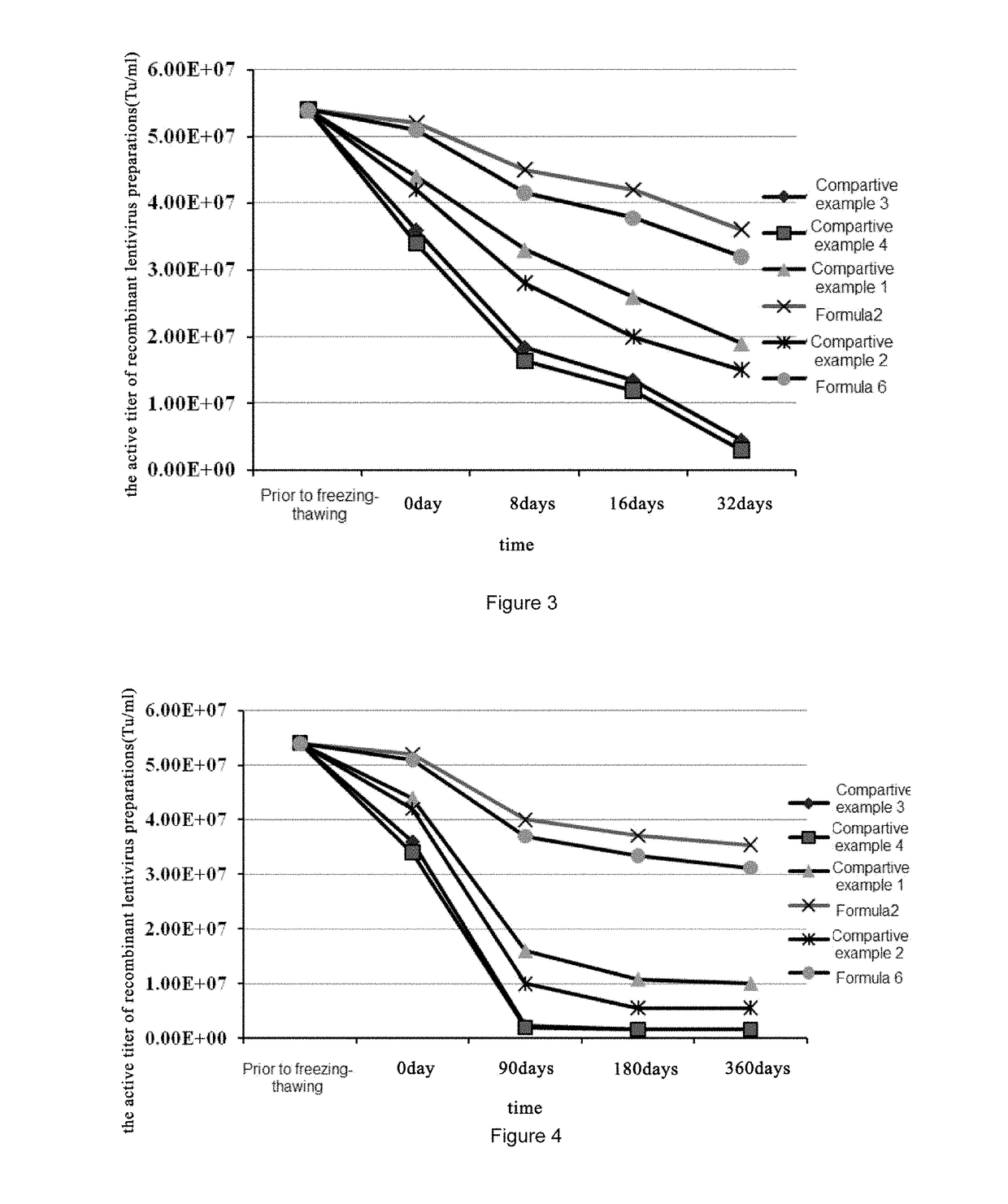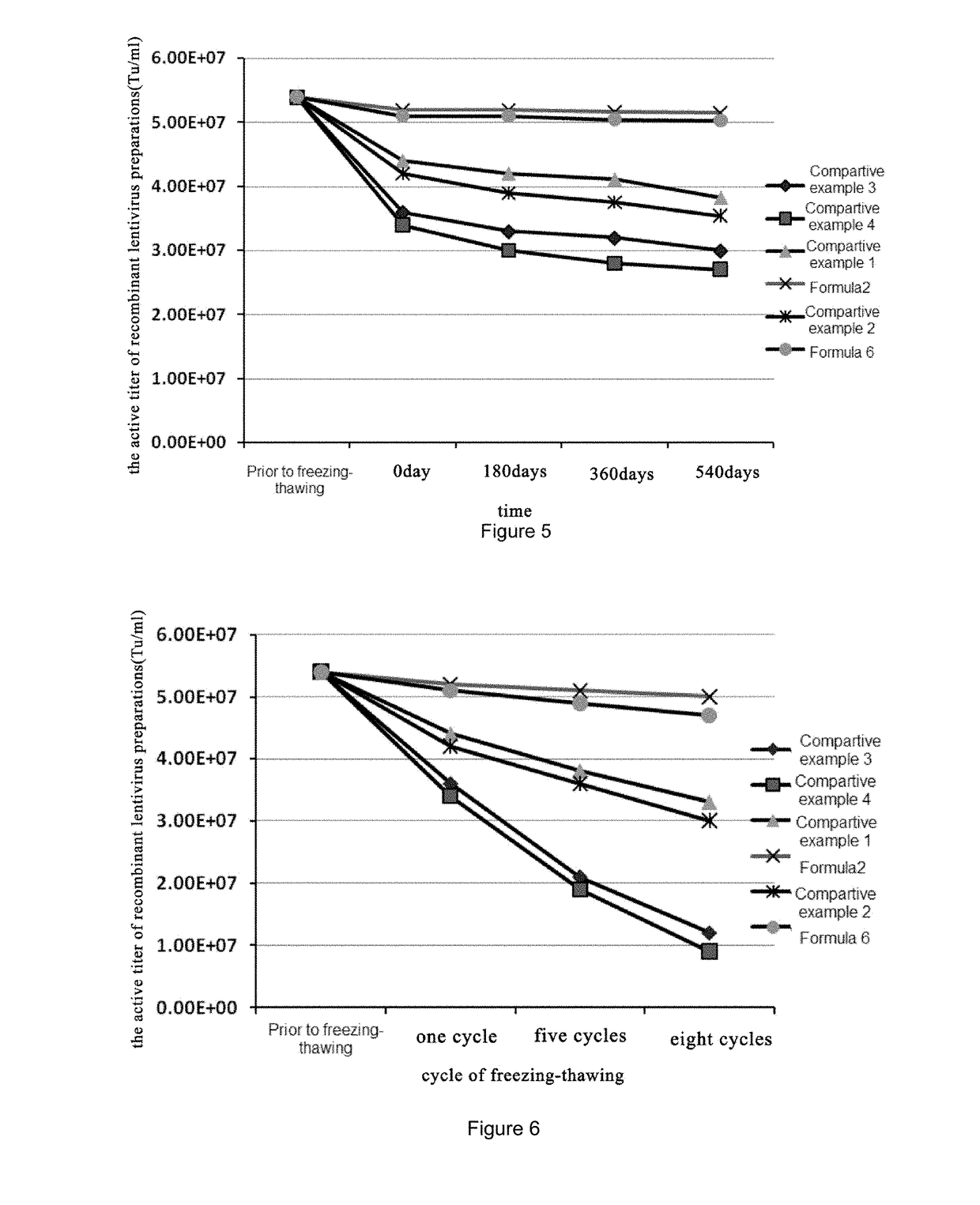Storage stable recombinant lentiviral vector preparation
a lentiviral vector and stable technology, applied in the field of recombinant lentiviral vector preparation, can solve the problems of lipid two-layer membrane damage, protein denaturation, and low stability of lentiviral vector, and achieve the effect of prolonging stability and keeping long-term stability
- Summary
- Abstract
- Description
- Claims
- Application Information
AI Technical Summary
Benefits of technology
Problems solved by technology
Method used
Image
Examples
preparation example
Preparation Example 1. Preparation of a SIV Lentiviral Vector Carrying PEDF and Determination of Titer Thereof
[0075]1. Preparation of a SIV Lentiviral Vector Carrying PEDF
[0076]a SIV gene transfer vector, a packaging vector, a rev expression vector, and a VSV-G expression vector were obtained with reference to the method in the patent CN200680012882 and the hPEDF fragment is introduced into the gene transfer vector. Among them, the obtained gene transfer vectors include three types, ie., a gene transfer vector with the cPPT fragment alone, a gene transfer vector with the WPRE fragment alone and a gene transfer vector with both cPPT and WPRE fragments.
[0077]The cell line 293T cells derived from human fetal kidney cells were seeded at a cell density of approximate 1×107 cell per plastic Petri dish having the diameter of 15 cm (cell density of 70-80% next day) and cultured in 20 ml of D-MEM culture medium (Gibco BRL) supplemented with 10% fetal bovine serum for 24 hrs. After 24 h of cu...
preparation example 2
Lentiviral Vector Carrying PEDF and Determination of Titer Thereof
[0089]2-1. Construction of the Recombination Lentivirus Gene Transfer Vector HIV-hPEDF
[0090]The hPEDF CDS fragment was PCR amplified from cDNA of the human Retinal pigment epithelium cell strain ARPE-19 (purchased from American type culture collection, ATCC) as a template using the following primers:
[0091]
(SEQ ID NO: 1)hPEDF-Forword (forward primer):atgcaggccctggtgctactcc;(SEQ ID NO: 2)hPEDF-Reverse (reverse primer):ttaggggcccctggggtccag.
[0092]Cycling conditions for the PCR reaction were as follows: denaturation at 95° C. for 5 min, 40 cycles of 95° C., 30 s; 60° C., 1 min; 72° C., 45 s, final elongation at 72° C. for 10 min.
[0093]The hPEDF fragment obtained by gel recovery was ligated into the pLenti6.3 / V5-TOPO® vector (Invitrogen) by TA cloning procedure following the manufacturer's instruction. The sequence of the ligated hPEDF fragment was verified by sequencing.
[0094]2-2. Large-Scale Preparation of the HIV Lentiv...
preparation example 3
ntiviral Vector Preparation
[0096](1) Preparation of the Lentiviral Vector Preparation of Formula 2
[0097]1. Preparing a preservation solution for the lentiviral vector: 150 ml of 10 mM histidine hydrochloride buffer was measured, 20 g of trehalose was added, the resulting mixture was stirred to mix well, and diluted with 10 mM histidine hydrochloride to 200 ml and the pH is adjusted to 7.2 for use.
[0098]2. Formulation of the Preparation of Formula 2
[0099]2×1010 TU / ml of the viral vector obtained in the Preparation Example 2 was diluted with D-PBS to 5.4×107 Tu / ml, 1 ml of the dilution was pipetted into a labelled ultra-filtration tube and diluted with the above-mentioned preservation solution to 15 ml. After centrifugation at 4° C., 3000 rpm / min for 2-3 min, the supernatant was discarded and 3 ml of the remaining liquid was retained. The retained liquid was diluted with the above-mentioned preservation solution to 15 ml again and re-centrifuged one time at 3000 rpm / min. The final vol...
PUM
| Property | Measurement | Unit |
|---|---|---|
| molar concentration | aaaaa | aaaaa |
| molar concentration | aaaaa | aaaaa |
| temperature | aaaaa | aaaaa |
Abstract
Description
Claims
Application Information
 Login to View More
Login to View More - R&D
- Intellectual Property
- Life Sciences
- Materials
- Tech Scout
- Unparalleled Data Quality
- Higher Quality Content
- 60% Fewer Hallucinations
Browse by: Latest US Patents, China's latest patents, Technical Efficacy Thesaurus, Application Domain, Technology Topic, Popular Technical Reports.
© 2025 PatSnap. All rights reserved.Legal|Privacy policy|Modern Slavery Act Transparency Statement|Sitemap|About US| Contact US: help@patsnap.com



